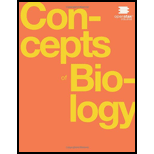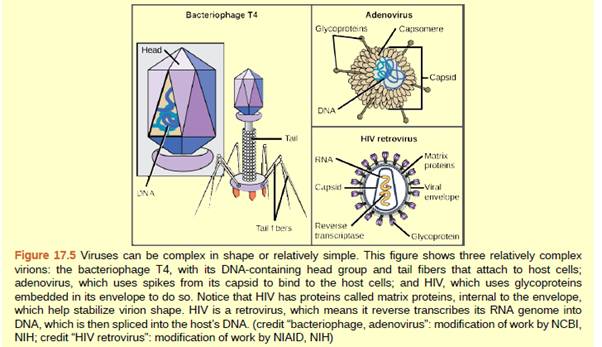
Concept explainers
Figure 17.5 Which of the following statements about virus structure is true?
a. All viruses are encased in a viral membrane.
b. The capsomere is made up of small protein subunits called capsids.
c. DNA is the genetic material in all viruses.
d. Glycoproteins help the virus attach to the host cell.

Introduction:
Viruses have diversity in terms of the structure, the method of replication, host and target cells. Viruses are non-cellular and parasitic and do not have any internal organelles, metabolic process or plasma membrane. The virion consists of a nucleic acid core of either DNA or RNA, an outer coating of protein, or sometimes may have an outer membrane which is made up of phospholipid membrane which is derived from the host cell and proteins.
Answer to Problem 1ACQ
Correct answer:
The correct answer is option (d) Glycoproteins help the virus attach to the host cell.
Explanation of Solution
Explanation/justification for the correct answer:
Option (d) Glycoproteins help the virus attach to the host cell. All the virions have the nucleic acid genome which is covered with an outer protein protective layer is termed as capsid. Capsomere is small protein subunits that make up the capsid. The capsid of some of the viruses has a surrounding outer structure which is the viral envelope.
All the viruses contain some kind of the glycoprotein for attachment to the host cell molecules which are the viral receptors. These cell surface molecules are exploited by viruses for recognition and infection to particular types of cell. So, the correct answer is option (d).
Explanation for the incorrect answer:
Option (a) All viruses are encased in a viral membrane. Viruses may or may not have a viral membrane. So, this is an incorrect option.
Option (b) The capsomere is made up of small protein subunits called capsids Capsomere are small protein subunits that make up the capsid. So, this is an incorrect answer.
Option (c) DNA is the genetic material in all viruses. The virion consists of a nucleic acid core of either DNA or RNA. So, this is an incorrect answer.
All the viruses contain some kind of the glycoprotein for attachment to the host cell molecules which are the viral receptors. These cell surface molecules are exploited by viruses for recognition and infection to particular types of cell. Hence, the correct answer is option (d) Glycoproteins help the virus attach to the host cell.
Want to see more full solutions like this?
Chapter 17 Solutions
Concepts of Biology
Additional Science Textbook Solutions
Campbell Biology in Focus (2nd Edition)
Genetic Analysis: An Integrated Approach (3rd Edition)
Microbiology with Diseases by Body System (5th Edition)
Biology: Life on Earth (11th Edition)
Anatomy & Physiology (6th Edition)
Chemistry: A Molecular Approach (4th Edition)
- What is this?arrow_forwardMolecular Biology A-C components of the question are corresponding to attached image labeled 1. D component of the question is corresponding to attached image labeled 2. For a eukaryotic mRNA, the sequences is as follows where AUGrepresents the start codon, the yellow is the Kozak sequence and (XXX) just represents any codonfor an amino acid (no stop codons here). G-cap and polyA tail are not shown A. How long is the peptide produced?B. What is the function (a sentence) of the UAA highlighted in blue?C. If the sequence highlighted in blue were changed from UAA to UAG, how would that affecttranslation? D. (1) The sequence highlighted in yellow above is moved to a new position indicated below. Howwould that affect translation? (2) How long would be the protein produced from this new mRNA? Thank youarrow_forwardMolecular Biology Question Explain why the cell doesn’t need 61 tRNAs (one for each codon). Please help. Thank youarrow_forward
- Molecular Biology You discover a disease causing mutation (indicated by the arrow) that alters splicing of its mRNA. This mutation (a base substitution in the splicing sequence) eliminates a 3’ splice site resulting in the inclusion of the second intron (I2) in the final mRNA. We are going to pretend that this intron is short having only 15 nucleotides (most introns are much longer so this is just to make things simple) with the following sequence shown below in bold. The ( ) indicate the reading frames in the exons; the included intron 2 sequences are in bold. A. Would you expected this change to be harmful? ExplainB. If you were to do gene therapy to fix this problem, briefly explain what type of gene therapy youwould use to correct this. Please help. Thank youarrow_forwardMolecular Biology Question Please help. Thank you Explain what is meant by the term “defective virus.” Explain how a defective virus is able to replicate.arrow_forwardMolecular Biology Explain why changing the codon GGG to GGA should not be harmful. Please help . Thank youarrow_forward
- Stage Percent Time in Hours Interphase .60 14.4 Prophase .20 4.8 Metaphase .10 2.4 Anaphase .06 1.44 Telophase .03 .72 Cytukinesis .01 .24 Can you summarize the results in the chart and explain which phases are faster and why the slower ones are slow?arrow_forwardCan you circle a cell in the different stages of mitosis? 1.prophase 2.metaphase 3.anaphase 4.telophase 5.cytokinesisarrow_forwardWhich microbe does not live part of its lifecycle outside humans? A. Toxoplasma gondii B. Cytomegalovirus C. Francisella tularensis D. Plasmodium falciparum explain your answer thoroughly.arrow_forward
- Select all of the following that the ablation (knockout) or ectopoic expression (gain of function) of Hox can contribute to. Another set of wings in the fruit fly, duplication of fingernails, ectopic ears in mice, excess feathers in duck/quail chimeras, and homeosis of segment 2 to jaw in Hox2a mutantsarrow_forwardSelect all of the following that changes in the MC1R gene can lead to: Changes in spots/stripes in lizards, changes in coat coloration in mice, ectopic ear formation in Siberian hamsters, and red hair in humansarrow_forwardPleiotropic genes are genes that (blank) Cause a swapping of organs/structures, are the result of duplicated sets of chromosomes, never produce protein products, and have more than one purpose/functionarrow_forward
 Concepts of BiologyBiologyISBN:9781938168116Author:Samantha Fowler, Rebecca Roush, James WisePublisher:OpenStax College
Concepts of BiologyBiologyISBN:9781938168116Author:Samantha Fowler, Rebecca Roush, James WisePublisher:OpenStax College Biology (MindTap Course List)BiologyISBN:9781337392938Author:Eldra Solomon, Charles Martin, Diana W. Martin, Linda R. BergPublisher:Cengage Learning
Biology (MindTap Course List)BiologyISBN:9781337392938Author:Eldra Solomon, Charles Martin, Diana W. Martin, Linda R. BergPublisher:Cengage Learning Biology Today and Tomorrow without Physiology (Mi...BiologyISBN:9781305117396Author:Cecie Starr, Christine Evers, Lisa StarrPublisher:Cengage Learning
Biology Today and Tomorrow without Physiology (Mi...BiologyISBN:9781305117396Author:Cecie Starr, Christine Evers, Lisa StarrPublisher:Cengage Learning Biology 2eBiologyISBN:9781947172517Author:Matthew Douglas, Jung Choi, Mary Ann ClarkPublisher:OpenStax
Biology 2eBiologyISBN:9781947172517Author:Matthew Douglas, Jung Choi, Mary Ann ClarkPublisher:OpenStax Biology: The Dynamic Science (MindTap Course List)BiologyISBN:9781305389892Author:Peter J. Russell, Paul E. Hertz, Beverly McMillanPublisher:Cengage Learning
Biology: The Dynamic Science (MindTap Course List)BiologyISBN:9781305389892Author:Peter J. Russell, Paul E. Hertz, Beverly McMillanPublisher:Cengage Learning





